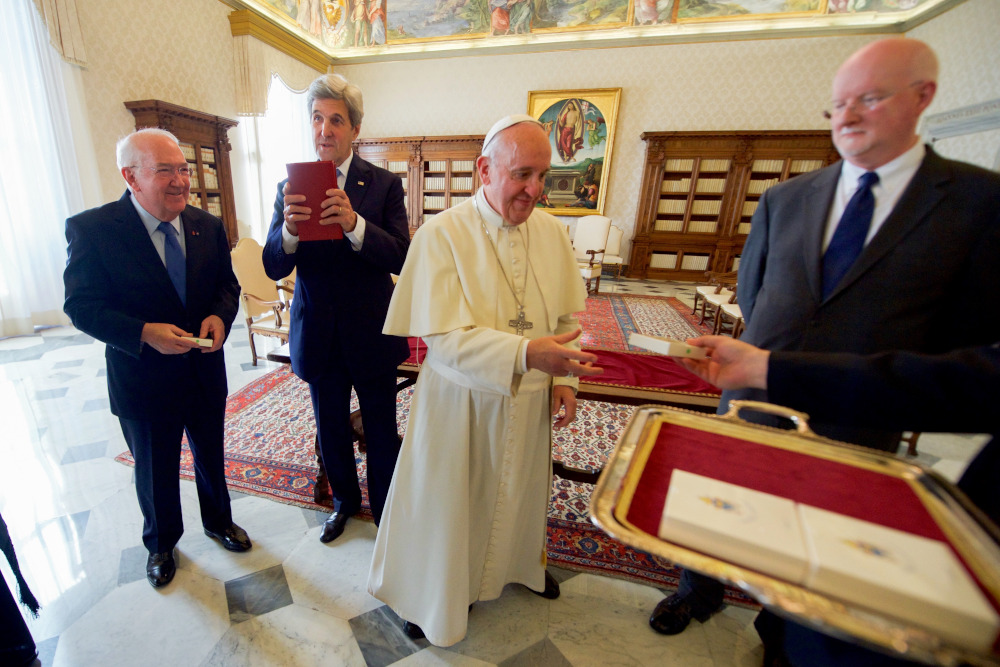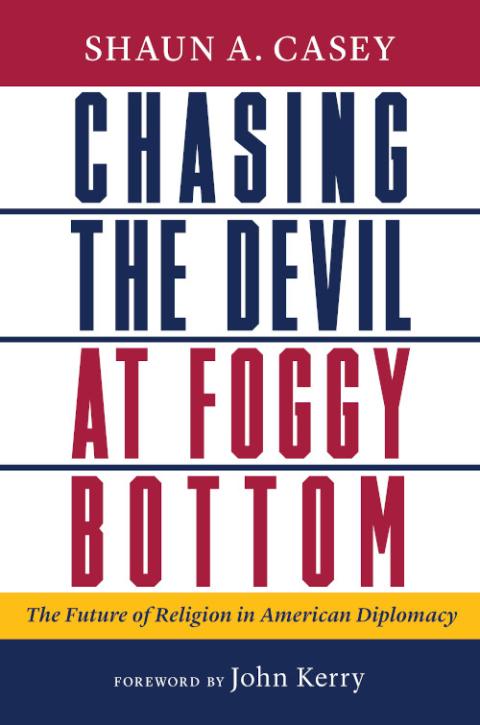Shaun Casey, the U.S. special representative for religion and global affairs in the U.S. State Department, is pictured in a 2013 photo. (CNS/Courtesy of State Department)
Reading about religion or politics is usually interesting, but reading about the estuary where the two come together is always interesting. Shaun Casey's book, Chasing the Devil at Foggy Bottom: The Future of Religion in American Diplomacy, is all about that estuary, seen through the privileged, specific lens of his effort to create a specific section of the State Department, the Office of Religion and Global Affairs, dedicated to analyzing the role of religion in American foreign policy.
Casey precedes his account with a brief survey of some of the more important books on religion and public policy in recent decades, strongly criticizing Samuel Huntington's The Clash of Civilizations and Remaking of World Order and praising former Secretary of State Madeleine Albright's The Mighty and the Almighty: Reflections on America, God, and World Affairs. Indeed, he sees in the latter book the basic justification for the office he would later be asked to set up.
Casey writes that Albright acknowledged the central role religion played in many of the issues she faced, from the Balkans to the Mideast, from Vietnam to Uganda, but had no group of experts upon whom she could draw for advice. "In contrast, she had armies of experts on economics, history, politics, military affairs, nuclear nonproliferation, and a raft of other issues to call upon when she needed advice," Casey writes. When John Kerry became Secretary of State in 2013, he turned to Casey to fill that gap in departmental expertise.
Casey makes some interesting observations about learning to navigate the bureaucracy. One story displays Casey's gift for humor and storytelling. He knew longtime Kerry aide David McKean and, during the early months, Casey "mentioned to him that George Kennan, the founder of the Office of Policy Planning, and perhaps the most well-known American diplomat in the twentieth century, once hired theologian Reinhold Niebuhr as a consultant. Without missing a beat, David proposed a deal. If I never compared him to Kennan, he would never compare me to Niebuhr!"
The "aspiration" of the office was that "each US embassy and post would have a curated landscape of lived religion that allowed them to develop a deep knowledge of the religious communities and actors in their host country and to build a working relationship with as many of them as possible."
It sounds simple but Casey understood the challenges. "Religion in the abstract is easy to hypothesize and market," he writes. "Religion embedded in national, local, or regional contexts is diabolically hard to understand. It takes patience, humility, deep study, and collaborative interrogation to begin to find understanding."
Advertisement
It also takes knowing how to throw a sharp elbow within the bureaucracy. The quotes above about the aspiration of his work come after Casey explains what he did not want to do, namely, get conscripted into the department's "countering violent extremism" or CVE work. "From time to time we jokingly referred to our work as CCVE, as in countering countering violent extremism," he writes.
CVE was a rebranding of the Bush administration's war on terror. "I am aware of no evidence that any of the hundreds of millions of US tax dollars spent in the name of CVE prevented any violent extremism anywhere," he writes damningly. "The global top-down approach that ironically claimed to want to empower local communities and fund evidence-based programming never reaped results."
The involvement of Casey and his team in countering violent extremism work came when the undersecretary of Civilian, Security, Democracy and Human Rights, Sarah Sewall, tried to enlist the Office of Religion and Global Affairs in her idea that the U.S. government devise "an imam-training curriculum that Muslim majority countries, primarily in the Gulf, could implement." Casey notes, "My head almost exploded at the many problems I saw in that proposal."
He attributes the lack of scrutiny given to an idea like this in part to ignorance of religious sensibilities but also to the growing influence of management ideas into policy formation. "What were needed were 'deliverables,' in policy speak, and she wasn't particularly interested in getting advice from actual experts on Islam."
Casey pummels Sewall, and the reader can be forgiven for thinking there was personal bad blood between them. A few others come in for similar treatment from Casey's pen. On the one hand, this is refreshing: Too many Washington memoirs are white-washed accounts, devoid of bridge-burning, especially if the author wants to return to the game. On the other hand, such incessant personal criticism clouds the more important concerns raised about the policies, such as this at the end of the section: "[W]e need to abandon the CVE framework altogether and relocated religion in a broader diplomatic framework of mitigating conflict."
Still, it is difficult not to commend Casey for his candor. Who cares if more authors get checked off some Christmas card lists because they provide a more accurate picture of the way personalities and policies clash and combine in places closed to the rest of us, like the seventh floor of the State Department!

U.S. Special Representative for Religion and Global Affairs Shaun Casey looks on as Pope Francis prepares to present him with a Papal medallion on December 2, 2016, following a one-on-one meeting with U.S. Secretary of State John Kerry in the Papal Apartments at the Vatican in Vatican City. (Wikimedia Commons/State Department)
The chapter on climate change is exceedingly well done. "As a teacher of ethics, I came to see that there were moral, theological, policy and scientific aspects to the problem, and very few people had the tools or energy to see all these dimensions at once. … And higher education, with its hyperspecialization and territorial intellectual silos, was increasingly ill-equipped to teach all the dimensions of the problem and its possible solutions," he writes.
Casey identified "three relevant sets of actors in the space at the intersection of religion and climate change." These were "the religiously affiliated or adjacent organizations," the "secular environmental groups … large, well-funded, politically savvy Washington players," and finally "the climate policy shops dispersed across the executive branch of government."
Pulling the three together was going to be a challenge. "I termed this the 'Can the marriage be saved initiative'," he writes. Casey's efforts to get the groups collaborating in advance of the Paris climate summit would soon get a big boost from the Vatican, with Pope Francis releasing his encyclical Laudato Si' followed by his coming to the United States that same year.
I won't give away all the ins-and-outs of the tale — you need to buy the book for that! But, one anecdote from the planning of the visit captures some of the disconnect between organized religion and politics in the nation's capital. Casey recalls being invited by Sen. Ed Markey to come speak to the Senate Climate Caucus about the pope's visit, and that both Sen. Al Franken and Sen. Chris Murphy were there as well. In assessing the pope's ability to withstand criticism in the court of public opinion, Casey asked Franken how many followers he had on Twitter and "the number was in the range of five figures. I noted that Pope Francis has millions of followers at that point … and any Republican who attacked Francis during his visit was probably not doing the climate-change denier cause any favors." In the event, it was Catholic climate deniers who took the lead in criticizing the pope.
Chapters on "Conflict" and "Responding to the Universe" follow. The former catalogs three instances when diplomacy has not been able to solve political tensions, and violence has ensued, in the Israeli-Palestinian conflict, the 2014 Russian invasion of Ukraine and in Ethiopia. The latter examines unplanned crises that demanded the attention of the State Department, in the Vatican, Cuba and Nigeria. In all six, Casey shows the possibilities and the limits of his office's ability to ameliorate challenges and advance the administration's policies.
"Religion embedded in national, local, or regional contexts is diabolically hard to understand. It takes patience, humility, deep study, and collaborative interrogation to begin to find understanding."
— Shaun Casey
Along the way, Casey drops some lovely observations about his project and the people he encountered. For example, he mentions the need to speak up at meetings, especially meetings with principals. "I found that drawing on history often worked," Casey writes. "I think this is due, in part, to many leaders in government having some sense of participating in a historical drama of sorts, and they want to do well under such conditions."
In discussing the Paris climate accords, Casey writes of the "common but differentiated responsibilities," a turn of phrase that I had not seen before but one which seems easily applicable to certain ecclesiological conundrums.
And in the chapter on conflict, when he analyzes the role of religious leaders, Casey observes, "If there is a lesson here, it may be that a degree of political independence and freedom to speak bluntly and publicly to one's political masters may be necessary for interreligious councils to have real impact on intransigent governments."
I could have chosen a dozen or so other examples of Casey's incisiveness.
There are a few quibbles here and there, but they are few and mostly inconsequential. He abuses the metaphor of the hedgehog and the fox, however, and it is a metaphor near and dear to my heart and thinking. The British philosopher Isaiah Berlin highlighted a fragment of a poem by Archilochus* that read: "The fox knows many things. But the hedgehog knows one big thing." Berlin used it, as Casey notes, to classify different types of thinkers, for example, Plato was a hedgehog and Aristotle a fox. Berlin did not say Plato's thought was bad or obtuse, but in Casey's telling, hedgehogs are simplistic, not unitary, and that is an abuse of the metaphor. What is more, Casey is not exactly correct when he states that Berlin used the distinction "for classifying great writers." Berlin does this in passing. The burden of the essay is about Tolstoy only, whom Berlin thought was a fox who desperately wanted to be a hedgehog. I may be the only reviewer who quibbles with this point.
Regular readers of this column are accustomed to reading about the intersection of politics and religion. Rarely does a book provide such a fascinating front row seat to the way these two spheres intersect within a branch of the U.S government. Casey tells his tale with a good balance of anecdote and analysis, and a fine writing style. You won't regret taking the time to read this volume.
Editor's note: The name of the poet in this paragraph has been corrected.








